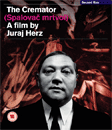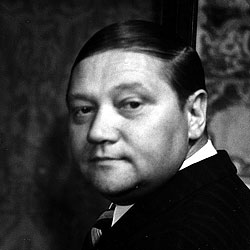
A short excerpt from the essay by Daniel Bird.
In The Cremator, director Juraj Herz presents us with a character that reconciles his own petit-bourgeois mentality not just with Buddhism but also with National Socialism. It falls between Dr. Strangelove (Stanley Kubrick, 1964) as a ‘blacker-than-black’ comedy about the apocalypse, and Repulsion (Roman Polanski, 1965) as a descent into madness.
First, about Herz himself: a Slovak born on 4th September 1934 - an exact contemporary of Jan Švankmajer. Like Švankmajer , Herz studied puppetry and theatre before being employed, like Švankmajer, at the Semafor Theatre in Prague. Herz acted in Švankmajer 's first film, The Last Trick of Mr Schwarzwald and Mr Edgar (Posledni trik pana Schawarcewaldea a pana Edgara, 1964) and some years later Švankmajer designed the sets for Herz's fairytale, The Ninth Heart (Devate srdce, 1978). By Herz's own admission, he and Švankmajer share a certain way of thinking and even if The Cremator is recognised as one of the classics of the ‘Czechoslovak New Wave’, it is with Jan Švankmajer’s early ‘mannerist’ films that offer the most fruitful comparison with Herz’s film, particularly in terms of cutting and music.
The Cremator is based on a book by Ladislav Fuks. According to Herz, he was actually unimpressed by the novel, but arranged to meet its author nonetheless. During the course of two years, the pair hammered out a literary script and, in 1968, the film went into production. However, Herz realised that there would soon be a Soviet clampdown and that The Cremator was probably his only chance to make a film with total artistic freedom. In August, shooting was interrupted by the Russian occupation of Czechoslovakia. Herz had yet to shoot many of the interiors and the Cremator himself, Rudolf Hrušínský, had gone into hiding. Hrušínský was at his summer home in South Bohemia when a Czech soldier advised him to go to the nearby airbase for his own safety. Bored after spending eight days there, Hrušínský returned to Prague to finish Herz's film.
The surrealist tone ofThe Cremator is underlined in a memorable title sequence featuring animated photographic cut outs of bodies. Kopfrkingl’s head is crudely ripped open to reveal a cascade of dismembered limbs. Interestingly, all of the photographic material here derives from the film itself, particularly the collection of photographs of girls used to entice Koprfkingl into joining ‘the Party’. The manner of the titles is reminiscent of the ‘fission-fusion’ games typical not just of Svankmajer’s animation but surrealism per se, not to mention broader trends under the influence of Borowczyk and Lenica.
Daniel Bird's complete essay, from which this short excerpt is taken, appears in the booklet which accompanies this release



Czechoslovakia / 1968
Main Feature: 100 minutes
Special Features: 44 minutes
Certificate: 15
Black & White
Original aspect ratio: 1.66:1
Language: Czech
Subtitles: English On/Off
Sound:
2.0 Dual Mono LPCM
BD50 / 1080 / 24fps
Region Free (A/B/C)
RRP: £19.99
Release Date: 11th Dec 2017

